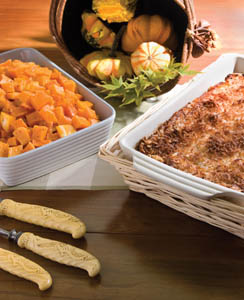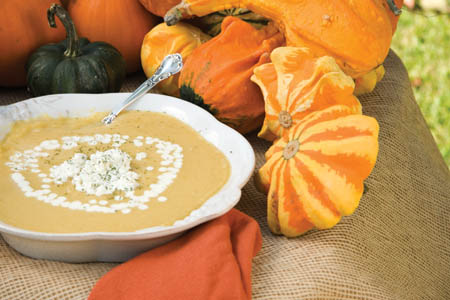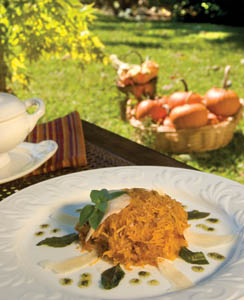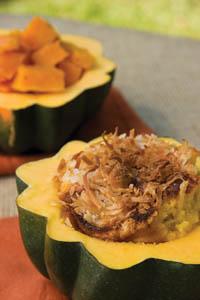Savor: Autumn’s Bountiful Harvest – Recipes!
BY Lindsay Key
It may be the most colorful oddball family around but don’t worry — it’s not yours. Members of the seed-bearing Cucurbitaceae family include rotund hundred-pound pumpkins and watermelons crinkled sunburst squash tubular zucchinis and even gnarled brightly banded snake gourds.
 These diverse plants are related by the internal seeds that — botanically speaking — make them fruits. Most grow in warm areas on thick green vines. In the fall the gourds make their way to our dinner tables in decorative display baskets and as food. The term “squash” denotes a gourd that is completely edible: Every bit of a squash can be and is consumed from its skin to its seeds.
These diverse plants are related by the internal seeds that — botanically speaking — make them fruits. Most grow in warm areas on thick green vines. In the fall the gourds make their way to our dinner tables in decorative display baskets and as food. The term “squash” denotes a gourd that is completely edible: Every bit of a squash can be and is consumed from its skin to its seeds.
Native Americans were quick to understand that squash was a staple crop. Known as one of the “Three Sisters” crops they planted it in abundance along with corn (maize) and beans. The Nahahiganseck tribe who controlled the Narragansett Bay in present-day Rhode Island gave squash its original name: askutasquash which literally means a “green thing eaten raw.”
Americans aren’t alone in their love of squash; it has many uses all over the world. In Latin America it’s made into candy or fermented beverages. In Mexico China and India its seeds are used in traditional folk medicines.
Now with the help of advanced agricultural technology most squash grow and are available year-round but they were once grouped under the labels “winter” or “summer” squash when season and location played a larger role in determining availability. Summer squash (including zucchini and yellow varieties) have thin skins and rarely keep past a week. Winter squash (including acorn butternut spaghetti and buttercup varieties) have thicker tougher skins and can be preserved for months if kept in cool basement-like areas. They are crammed with nutritious goodies like calcium beta carotene and antioxidants.
For this reason The Seasoned Gourmet’s Susan Boyles is comfortable serving her Mixed Autumn Squash Soup as a stand-alone meal or a starter during cooler months. The blend of butternut squash acorn squash vegetable stock cream and delicious seasonings makes for a hearty healthy meal on its own. To top it off Boyles likes to garnish the soup with a soft crumbling of goat cheese and a sprinkling of nutmeg.
“It’s a luxurious thick creamy recipe ” Boyles says. Although her mother often cooked with squash it took years for Boyles to fall in love with the taste of raw or what she calls “naked” squash.
Now the natural sweetness of the plant — which she equates to the subtle flavor of a sweet potato — is a craving of hers and a must-make/must-have in The Seasoned Gourmet kitchen in Lumina Commons where she hosts cooking classes and private parties.
Another local chef Marcus Buric also attributes his squash cravings to his mother Nina. The smell of a sizzling spaghetti squash sparks tender moments spent with her in the kitchen. Nina’s German-influenced side dish — a blend of basil fire-roasted tomato paste sweet caramelized onions and long yellow spaghetti squash noodles — captured his attention as a child with its warm seasoned smell and bright contrasting colors.
Today Buric creates a slight variation of that recipe for clients of his catering business Culinary Creations. Like his mother he uses a special tomato paste ordered from Germany but for those who don’t have the special paste he says store-bought tomato paste mixed with caramelized onions is a workable option.
There are two important things to remember when cooking with squash Buric says. Number one: Wash your squash. Many cooks seem to forget that it grows on the ground and your table guests will get a mouthful of grit if it is served unclean. Number two: Don’t overcook it.
“Spaghetti squash is one of those that if you overcook it it just becomes mush. You really want to have it almost like pasta a little bit crunchy. That’s the one thing I’ve always loved about the way my mom cooks it she always does it perfect.”
While perfection is a hard-to-reach goal Chef Beth Flaherty’s pumpkin ravioli recipe comes pretty close. Made with a relatively small two-pound pumpkin or butternut squash “it’s one of my absolute favorite dishes ” Flaherty says. “I think it shows the versatility of what you can do with squashes.”
As owner and chef of Coriander’s Fine Foods and Catering Flaherty has used her pumpkin ravioli recipe as a demo during classes reminding her students that the dish can serve as the first course of a fancy decadent dinner or simply a meal for two.
“The nice thing too is that once you make the ravioli they freeze beautifully. You can make up a whole batch of them and then pull them out when you need them ” Flaherty says. Her favorite recipe makes about 35 servings.
Although it’s often served as an entrée or side dish squash’s subtle sweetness can certainly be appreciated as a dessert thanks to the finesse of Pine Valley Market’s Christi Ferretti. Her soufflé is a medley of acorn butternut and buttercup squash whipped with coconut and cream for a light delicious slightly tropical endnote.
But this recipe is just one way of sweetening squash. For a quick weeknight fix Ferretti also recommends a much simpler Honey Roasted Butternut Squash recipe which combines the fruit with salt pepper canola oil and honey.
“Kids love it ” she says. “It’s a great way to get squash in their system and you can use all-natural or organic honey too. What I like about the honey is that it caramelizes on the outside so it gives it a little bit of that “caramelly” flavor and texture whereas if you don’t do it it’s just going to be a soft squash. It’s sweetened by itself because of the natural sugars that are in it.”
 Mixed Autumn Squash Soup (serves 6)
Mixed Autumn Squash Soup (serves 6)
Susan Boyles The Seasoned Gourmet
(1319-R Military Cutoff Road 910-256-9488)
1 large butternut squash
2 acorn squash
2 tablespoons unsalted butter
1 tablespoon kosher salt plus 1 teaspoon
1 teaspoon freshly ground white pepper plus ½ teaspoon
2 cups vegetable stock
4 tablespoons local premium honey
1 teaspoon minced ginger
1-plus cups heavy cream
1 teaspoon fresh ground nutmeg
Preheat the oven to 400 degrees Fahrenheit. Line a baking sheet with foil parchment or a Silpat. Rinse the squash well pat dry slice in half scoop out the seeds and place flesh down on the baking sheet. Put in the oven and roast for about 45 minutes until a steak knife slides easily into the flesh. Allow the squash to cool until you can handle it.
Meanwhile heat the stock in a deep stock pot over low heat whisking occasionally. Scoop the flesh from the skin into a food processor and add a cup of stock and the ginger — process until smooth and add to stock pot — whisk to combine. Or scoop squash directly into stock pot and use an immersion blender to purée. Add the honey and whisk.
Increase the heat to medium and bring to a simmer. Whisk in the heavy cream to desired consistency and return to a low simmer. Season with salt pepper and nutmeg to taste. Simmer to incorporate seasonings 20 minutes. Adjust seasoning to taste.
Serve warm. Note: If desired you can make this entirely from acorn or butternut squash. Use 4 acorn or 2 butternut squash in lieu of the mixed squash above.
 Spaghetti Squash with a Twist
Spaghetti Squash with a Twist
by Marcus Buric Culinary Creations (910-538-2433)
3 tablespoons butter
1 tablespoon olive oil
½ yellow sweet onion
½ cup chicken stock
1 medium spaghetti squash (cooked)
1½ tablespoons tomato paste
1 cup Parmesan cheese
Salt and pepper to taste
Slice the spaghetti squash in half long-ways and place on a sheet pan. Cover squash with water up to about ½ inch place in a 375-degree oven and bake for twenty minutes or until squash is soft to the touch. Remove from oven and pour off water. Turn the squash over and let cool. Once cool take a fork and gently scrape out insides working from the sides to the center.
Place 2 tablespoons butter and olive oil in a hot sauté pan and add onions. Caramelize the onions and add tomato paste and chicken stock. Let the chicken stock reduce by half stirring in the tomato paste till it dissolves.
Add spaghetti squash and season with salt and pepper and 1 tablespoon butter. Toss with Parmesan cheese garnish with fresh basil and serve.
 Honey Roasted Butternut Squash (serves 6-8)
Honey Roasted Butternut Squash (serves 6-8)
by Christi Ferretti Pine Valley Market (3520 South College Road 910-350-3663)
2 large butternut squash
2 teaspoons fresh ground pepper
1 teaspoon kosher salt
1/3 cup light olive oil or canola oil
1/4 cup honey
Preheat oven to 400 degrees. Trim ends off of butternut squash and using a peeler remove skin as well as the white flesh just below the skin. (Note: This can be done with a sharp knife but can be dangerous due to the firmness of the squash. A peeler takes a little time but works well.) Cut the squash in half separating the bulb end from the long end for easy cutting. Cut the squash into uniform cubes about 1 to 1.5 inches. Place the cubed squash in a large bowl drizzle with oil salt pepper and honey and toss well.
On a parchment-lined baking sheet spread out the squash into a single layer place on upper rack in preheated oven for eight minutes rotate baking sheet and bake for an additional five to eight minutes or until squash is beginning to brown and is tender. (Note: When measuring honey spray measuring cup liberally with pan spray then measure the honey. It will pour out easily ensuring proper measurement and less frustration!)
Squash Souffle (serves 6-8) pictured above foreground
by Christi Ferretti Pine Valley Market (3520 South College Road 910-350-3663)
Olive oil
Kosher salt
Fresh ground pepper
1 medium acorn squash
1 medium butternut squash
1 buttercup squash
½ cup packed brown sugar
¼ teaspoon salt
¼ teaspoon ground ginger
1 teaspoon vanilla extract
5 eggs separated
¼ cup heavy cream
½ cup cream of coconut
¼ cup (1/2 stick) butter melted
½ cup flaked sweetened coconut
To prepare the squash: cut in half drizzle with olive oil kosher salt and pepper. Loosely wrap each half in foil and bake in a 325-degree oven for one hour or until flesh is soft. Allow to cool and using a spoon scoop out the flesh and transfer to a large mixing bowl. Use an electric mixer or blender to purée the squash until smooth.
Preheat oven to 325 degrees. Lightly grease a two-quart casserole dish. In a large bowl use an electric mixer to mix the squash sugar salt ginger and vanilla and beat well. Add the yolks and beat well. Mix in the cream cream of coconut and melted butter until just combined.
In a separate bowl beat the egg whites until stiff but not dry. Gently fold the egg whites into the squash mixture. Pour into the prepared casserole dish and sprinkle with the coconut.
Bake 30 to 40 minutes until puffed and lightly browned. (Note: A single variety of squash can be used or others can be added. You can even use this recipe with sweet potatoes yams or pumpkin.)
Capellacci de Zucca — Pumpkin Ravioli
(makes 35 ravioli)
by Beth Flaherty Coriander’s Fine Foods and Catering (17011 US Highway 17 N Hampstead 910-270-3413)
1-2 pounds whole pumpkin or butternut squash (or 1.5 cups canned packed pumpkin)
2 large eggs
½ cup ricotta cheese
½ cup Reggiano Parmesan cheese
1/8 teaspoon nutmeg
Kosher salt and black pepper
1 package wonton wrappers
4-6 teaspoons butter
4 fresh sage leaves
Preheat oven to 350 degrees. Halve the squash and remove the seeds. Bake cut-side down for one hour or until tender. Scoop out the flesh discard the skin.
In a large mixing bowl mix the squash (or packed pumpkin) 1 egg ricotta 1/4 cup of the Parmesan and the nutmeg until smooth. Season to taste with salt and pepper and set aside.
Beat remaining egg with 1 tablespoon of water. Brush a wonton wrapper with egg wash. Place about 1 tablespoon of filling in the center of each wrapper fold to form a triangle and press firmly to seal. These can be assembled four to 24 hours before serving. (Keep chilled in refrigerator in a single layer on parchment or wax paper. Keep covered.)
Bring about 6 quarts of water to a boil and add about 2 tablespoons of salt. Drop pasta in the water and lower the heat to a high simmer. Cook until tender about three to four minutes.
Melt the butter in a sauté pan. When butter begins to brown add sage leaves. Gently drain the pasta and add to the pan with the butter. Brown for about one minute on each side and serve sprinkled with the remaining cheese. Makes about 35 ravioli.